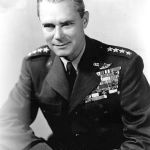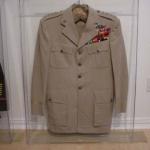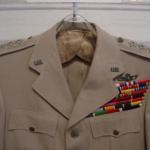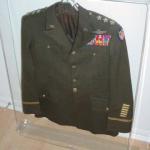Hoyt Vandenberg
- Rank Offices Held**** General, Second Chief of Staff and Director of the CIA
- Battles WarsAddWorld War II
- AwardsDistinguished Service Medal (2), Silver Star, Legion of Merit, Distinguished Flying Cross, Bronze Star, Air Medal (5)
- Loanable ObjectUniform
- StatusAvailable
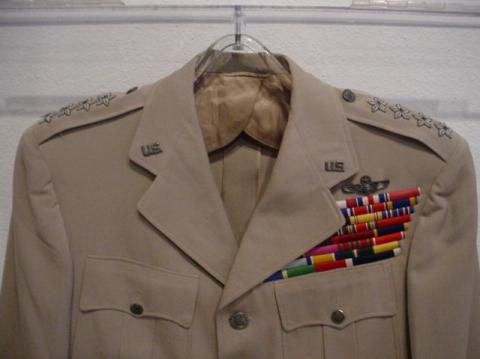
General Hoyt S. Vandenberg was the second chief of staff of the U.S. Air Force, Washington, D.C.
The general was born at Milwaukee, Wisconsin, in 1899. He graduated from the U.S. Military Academy June 12, 1923, and commissioned a second lieutenant in the Air Service.
- General Hoyt Vandenberg
- Loanable Object – Gen Hoyt Vandenberg Uniform
- Vandenberg Uniform
General Vandenberg graduated from the Air Service Flying School at Brooks Field, Texas, in February 1924, and from the Air Service Advanced Flying School at Kelly Field, Texas, in September 1924.
His first assignment was with the Third Attack Group at Kelly Field, where he assumed command of the 90th Attack Squadron. In 1927, he became an instructor at the Air Corps Primary Flying School at March Field, Calif. He went to Schofield Barracks, Hawaii, in May 1929, to join the Sixth Pursuit Squadron, and assumed command of it the following November.
Returning in September 1931, he was appointed a flying instructor at Randolph Field, Texas, and became a flight commander and deputy stage commander there in March 1933. He entered the Air Corps Tactical School at Maxwell Field, Alabama, in August 1934, and graduated the following June. Two months later he enrolled in the Command and General Staff School at Fort Leavenworth, Kansas, and completed the course in June 1936. He then became an instructor at the Air Corps Tactical School at Maxwell Field, where he
taught until September 1936, when he entered the Army War College.
After graduating from the War College in June 1939, General Vandenberg was assigned to the Plans Division in the Office of the Chief of Air Corps. A few months after the United States entered World War II, he became operations and training officer of the Air Staff. For his services in these two positions he received the Distinguished Service Medal.
In June 1943, General Vandenberg was assigned to the United Kingdom and assisted in the organization of the Air Forces in North Africa. While in Great Britain he was appointed chief of staff of the 12th Air Force, which he helped organize. On February 18, 1943, General Vandenberg became chief of staff of the Northwest African Strategic Air Force and with this air force he flew on numerous missions over Tunisia, Italy, Sardinia, Sicily and Pantelleria during the North African campaign. He was awarded both the Silver Star and the Distinguished Flying Cross for his services during this time. For his organizational ability with the 12th Air Force and his work as chief of staff of the Northwest African Strategic Air Force, he was awarded the Legion of Merit.
General Vandenberg, in August 1943, was assigned to Air Corps headquarters as deputy chief of air staff. A month later he became head of an air mission to Russia, under Ambassador Harriman, and returned to the United States in January 1944. Two months later he was transferred to the European theater, and in April 1944, was designated deputy air commander in chief of the Allied Expeditionary Forces and commander of its American Air Component. In August 1944, General
Vandenberg assumed command of the Ninth Air Force. On November 28, 1944, he received an oak leaf cluster to the Distinguished Service Medal for his part in planning the Normandy invasion.
He was appointed assistant chief of air staff at Air Corps headquarters in July 1945. The following January he became director of Intelligence on the War Department general staff where he serviced until his appointment in June 1945, as director of Central Intelligence. He returned to duty with the Air Corps in April 1947, and on June 15, 1947, became deputy commander and chief of air staff. He was designated vice chief of staff of the Air Force on Oct. 1, 1947, and promoted to the rank of general. On April 30, 1948, General Vandenberg became chief of staff of the Air Force, succeeding General Carl Spaatz. He was renominated by President Harry S. Truman for a second term as chief of staff March 6, 1952, to June 30, 1953, and the nomination was confirmed by the Senate on April 28, 1952.
General Vandenberg retired from active duty June 30, 1953. He has been awarded the Distinguished Service Medal with oak leaf cluster, Silver Star, Legion of Merit, Distinguished Flying Cross, Air Medal with four oak leaf clusters, Bronze Star, Victory Medal, American Campaign Ribbon, American Defense Ribbon and the European-African-Middle East Campaign Ribbon.
His foreign decorations include: Mexican Military Order of Merit; Netherlands Order of Orange Nassau (Grand Officer with Swords); Brazilian Cruz del Sol (Grand Officer), and Medal of War; Luxembourg Order of Adolph von Nassau (Grand Cross), and Croix de Guerre; Belgian Order of Leopold I (Grand Officer with Palms); and Croix de Guerre with Palms; British Order of the Bath (Knight Commanders Cross); Polish Order of Polish Restoration (2nd Class); Portuguese Ordem de Avis, Gra Cruiz; Egyptian L’Ordre Du Nil Grand Cordon; Chinese Order of Pao Ting (Tripod with Grand Cordon); Chilean Medallia Militar de Primerera Clase; Argentine General Staff Emblem and the Military Order of Italy.
General Hoyt S. Vandenberg was the second chief of staff of the U.S. Air Force, Washington, D.C.
The general was born at Milwaukee, Wisconsin, in 1899. He graduated from the U.S. Military Academy June 12, 1923, and commissioned a second lieutenant in the Air Service.
General Vandenberg graduated from the Air Service Flying School at Brooks Field, Texas, in February 1924, and from the Air Service Advanced Flying School at Kelly Field, Texas, in September 1924.
His first assignment was with the Third Attack Group at Kelly Field, where he assumed command of the 90th Attack Squadron. In 1927, he became an instructor at the Air Corps Primary Flying School at March Field, Calif. He went to Schofield Barracks, Hawaii, in May 1929, to join the Sixth Pursuit Squadron, and assumed command of it the following November.
Returning in September 1931, he was appointed a flying instructor at Randolph Field, Texas, and became a flight commander and deputy stage commander there in March 1933. He entered the Air Corps Tactical School at Maxwell Field, Alabama, in August 1934, and graduated the following June. Two months later he enrolled in the Command and General Staff School at Fort Leavenworth, Kansas, and completed the course in June 1936. He then became an instructor at the Air Corps Tactical School at Maxwell Field, where he
taught until September 1936, when he entered the Army War College.
After graduating from the War College in June 1939, General Vandenberg was assigned to the Plans Division in the Office of the Chief of Air Corps. A few months after the United States entered World War II, he became operations and training officer of the Air Staff. For his services in these two positions he received the Distinguished Service Medal.
In June 1943, General Vandenberg was assigned to the United Kingdom and assisted in the organization of the Air Forces in North Africa. While in Great Britain he was appointed chief of staff of the 12th Air Force, which he helped organize. On February 18, 1943, General Vandenberg became chief of staff of the Northwest African Strategic Air Force and with this air force he flew on numerous missions over Tunisia, Italy, Sardinia, Sicily and Pantelleria during the North African campaign. He was awarded both the Silver Star and the Distinguished Flying Cross for his services during this time. For his organizational ability with the 12th Air Force and his work as chief of staff of the Northwest African Strategic Air Force, he was awarded the Legion of Merit.
General Vandenberg, in August 1943, was assigned to Air Corps headquarters as deputy chief of air staff. A month later he became head of an air mission to Russia, under Ambassador Harriman, and returned to the United States in January 1944. Two months later he was transferred to the European theater, and in April 1944, was designated deputy air commander in chief of the Allied Expeditionary Forces and commander of its American Air Component. In August 1944, General
Vandenberg assumed command of the Ninth Air Force. On November 28, 1944, he received an oak leaf cluster to the Distinguished Service Medal for his part in planning the Normandy invasion.
He was appointed assistant chief of air staff at Air Corps headquarters in July 1945. The following January he became director of Intelligence on the War Department general staff where he serviced until his appointment in June 1945, as director of Central Intelligence. He returned to duty with the Air Corps in April 1947, and on June 15, 1947, became deputy commander and chief of air staff. He was designated vice chief of staff of the Air Force on Oct. 1, 1947, and promoted to the rank of general. On April 30, 1948, General Vandenberg became chief of staff of the Air Force, succeeding General Carl Spaatz. He was renominated by President Harry S. Truman for a second term as chief of staff March 6, 1952, to June 30, 1953, and the nomination was confirmed by the Senate on April 28, 1952.
General Vandenberg retired from active duty June 30, 1953. He has been awarded the Distinguished Service Medal with oak leaf cluster, Silver Star, Legion of Merit, Distinguished Flying Cross, Air Medal with four oak leaf clusters, Bronze Star, Victory Medal, American Campaign Ribbon, American Defense Ribbon and the European-African-Middle East Campaign Ribbon.
His foreign decorations include: Mexican Military Order of Merit; Netherlands Order of Orange Nassau (Grand Officer with Swords); Brazilian Cruz del Sol (Grand Officer), and Medal of War; Luxembourg Order of Adolph von Nassau (Grand Cross), and Croix de Guerre; Belgian Order of Leopold I (Grand Officer with Palms); and Croix de Guerre with Palms; British Order of the Bath (Knight Commanders Cross); Polish Order of Polish Restoration (2nd Class); Portuguese Ordem de Avis, Gra Cruiz; Egyptian L’Ordre Du Nil Grand Cordon; Chinese Order of Pao Ting (Tripod with Grand Cordon); Chilean Medallia Militar de Primerera Clase; Argentine General Staff Emblem and the Military Order of Italy.

